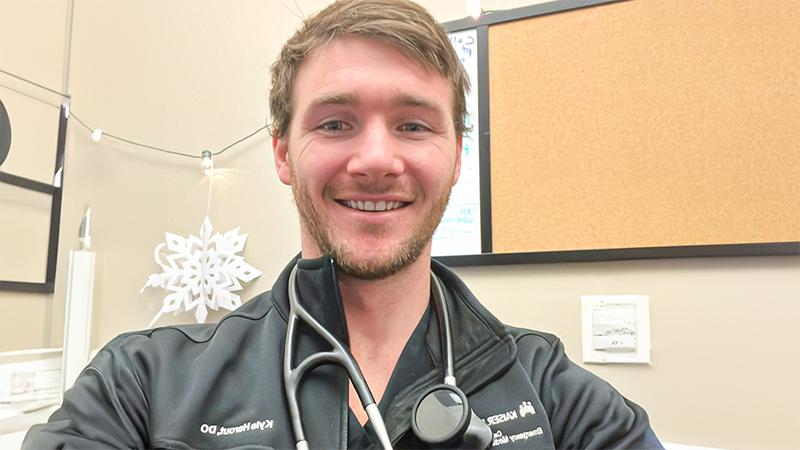From EMT to ER physician
As an emergency medical technician (EMT), Kyle Herout, DO, loved the action and excitement of helping patients in urgent situations. The experience convinced him to steer his career from the ambulance to the emergency department (ED).
“While I was in college, I worked as an EMT and spent time in the ED. I really enjoyed the emergency, acute-care type of medicine. After I graduated, I went off to medical school, and now I’m going to be entering my third year of residency,” said Dr. Herout, who practices in Modesto, California.
Dr. Herout enjoys working in an environment that is busy, demanding, and different every day.
“I’m a bit of an adrenaline junkie, and in the emergency medicine field, you never know what you’re going to get. Things can be either super quiet or super hectic. It’s that whole surfing mentality, like you never know when the big wave is going to break,” says the California native. “That applies to the emergency medicine field. Plus, it fits my personality really well.”
The ED is a loud place to work, so Dr. Herout has come to rely on the Eko CORE 500™ stethoscope’s digital amplification and noise cancellation capabilities to eliminate the significant background noise. Eko’s newest audio innovation, TrueSound™, helps him hear heart, lung, and bowel sounds with much better clarity. The technology includes in-ear speakers, 40x amplification, active noise cancellation, and three audio filter modes. “It can be challenging to hear sounds with a typical stethoscope, especially if there are lots of alarms going off and ancillary staff all trying to talk and get things done,” he said. “By far, the CORE 500™ surpasses the auditory capabilities of any other stethoscope I’ve ever listened to. You actually hear the stuff that matters. The sounds are unmatched.”
When he finds himself using a non-digital stethoscope, such as during a recent rotation with EMTs, he misses the CORE 500™’s amplification and noise cancellation. He said both emergency room clinicians and EMTs can really benefit from the technology.
Digital stethoscopes help assess ED lobby patients
Among the challenges in the post-COVID world is a phenomenon new to his semi-rural ER — “lobby patients.”
“Ever since COVID, our volumes have been much higher than our facilities can accommodate, and our staffing is typically lower than what we need. So, a lot of my patients end up being treated from a lobby setting,” he said. “I often get patients who are pulled into the ER so I can quickly evaluate them and make some decisions about putting in orders. Then they spend most of the next couple of hours in the lobby. They get shuffled around to various departments: lab draws, X-ray, CT. They might even be given some meds in a hallway chair. Unless they really need IV fluids and IV medications; they’ll spend most of their time in the lobby.”
When patients spend the majority of time in the lobby, they don’t receive regular assessments of their vital signs. That can make it difficult to determine whether interventions or supportive medications have been effective, he said. Dr. Herout uses the CORE 500™ to reassess patients and improve departmental workflow in this new normal. The newest iteration of the Eko technology includes real-time heart rate measurement, and electrocardiogram (ECG) tracing — all on a full-color display. Because the feature is built right into the stethoscope, it’s highly portable.
“It speeds up the department flow because I don’t have to wait for the nursing staff to find the patient and get vital signs,” he said. “I can quickly assess them myself, make decisions, and ask the nurse to get a formal set of vital signs while I put in the discharge paperwork.”
Can’t-miss diagnoses don’t slip by with the Eko CORE 500™
In the ED, there are certain “can’t-miss diagnoses,” Dr. Herout said. These have dire consequences when not identified quickly and accurately, such as heart attack, aortic dissection, and pulmonary embolism. Hearing heart sounds accurately is the main hurdle to diagnosing such conditions correctly, he added.
“For example, a patient with new-onset chest pain and new-onset murmur is more concerning than the same patient without the murmur,” he said. “With a lot of traditional stethoscopes, subtle murmurs are hard to pick up. Using the CORE 500™, I notice I ask patients more frequently if they’ve had a diagnosis of a heart murmur because I am actually hearing murmurs much more often.”
This information can make the difference between determining if a patient needs a higher sense of urgency, a cardiology consultation before discharge, or a hospital admission for an inpatient ECG, he said.
“In the ED, we have to look at a patient and make split-second decisions. How well is the patient breathing? Do I need to intubate? Having something that will increase your level of confidence that you are — or are not — hearing something, especially in those high-stress situations, is very helpful.”
The future of artificial intelligence in medicine
The newest Eko digital stethoscopes can pair with the Eko App, which contains AI algorithms that flag abnormalities including atrial fibrillation (AFib), bradycardia, and tachycardia. Dr. Herout worked with Eko to test the AI analysis for the detection of AFib.
“AI can be a complement to human knowledge and decision-making,” he says. “It has the benefit of drawing our attention to things. Then I can review what it’s highlighting and decide whether it is right or not,” he said. “Most providers are going to rely on their own interpretation of the clinical scenario because they actually see the patient. They see the charts. They see what medications have been prescribed. But AI can enhance the clinician’s judgment.”
Learn why the Eko CORE 500™ Digital Stethoscope is such a powerful tool for detecting and listening to body sounds, even in a busy ER or ED lobby.
MKT-0002142 Rev 1.0
